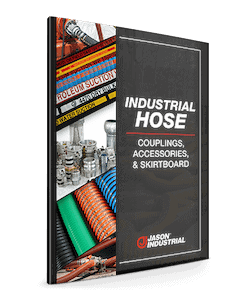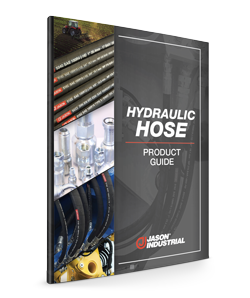A hose is a flexible, reinforced rubber or thermoplastic conduit that is used to convey fluid within a hydraulic or process system. These hoses are often reinforced with several material layers to withstand the required pressure of the system it is being used within.
One of the most fundamental considerations when selecting hose is sizing. If the hose is too small of inside diameter, pressure losses could be high and excessive flow-rate will create heat which leads to damaging the hose inner tube and possibly creating flow erosion of the hose’s tube. This can lead to damage of seals, clogged pumps, valves, and filters as well as failure of the hose itself. If the hose is too large of inside diameter, the volume of fluid contained will be greater than needed for function of the equipment and routing of the hose may be difficult. Additionally, the costs of the larger hose assembly and connections may be higher than actually needed. Response time will also be delayed on hydraulic systems if the hoses are too large.
As you can see, proper selection of sizing is very important when specifying a hose for a particular application.
Hose Sizing Metrics
Hose size is determined based on the inner diameter (I.D.), along with the flow rate of fluid within the system.
Inner Diameter
Hose sizes are designated based on the inner diameter of the hose, which is the measurement of the straight distance between the two furthest points on the inner surface of the tube. Virtually all hoses made globally are made on inch sizes even if given a metric size designation.
Most hoses used in North America are designated in inches of ID. For industrial hoses, it is most common to see the size in direct terms of the inch size. For example, a 3/4” measured hose ID will be designated as either a “3/4” or in terms of decimal size “.75”. The metric nominal equivalent may also be referenced as well, but keep in mind that this just a reference in most cases. In the vast majority of common hydraulic hoses, the I.D. measurement is divided into 1/16” increments known as the “dash size.” For example, a hose measuring 3/4” ID will be shown as a “-12” coming from the numerator of the fraction of 3/4″=12/16”. A 1” ID would be 16/16 or a -16, and so on. There are notable exceptions to this designation namely SAE 100R5, 100R14, and certain other hoses used in airbrake and refrigerant applications. These are based on tube connection ID sizes and consultation with cataloged information will be helpful to properly understand the designation for any of these hoses.
Outer Diameter
The outer diameter (O.D.) of the hose includes the entire cross-section of the hose. Although the O.D. can be used to ensure the hose fits within the allotted space, it has no direct impact on pressure loss and flow calculations within systems.
Length
The hose size must also take into account the maximum distance between the two end points of the hose. As hose length increases, so does the friction losses between the fluid and the inner surface of the hose, which reduces pressure inside the system. You should therefore consider the hose length when calculating system pressure requirements. Going slightly larger ID will reduce the pressure loss (also known as pressure drop).
Flow Rate
The flow rate (expressed as gallons per minute or liters per minute) or velocity (expressed as feet per second or meters per second) of the fluid moving within the system is the key to understand when sizing the hose for proper performance. The maximum system flow rate is determined primarily from the ratings of the pump used. Pump data may be found on the pump manufacture tag, system specifications or from the pump manufacturer’s catalog or website. Sometimes this is expressed as “pump curves” which are based on several variables including speed at which the pump is being driven.
Once the system maximum flow rate is established, use the nomograph supplied in the Jason hose product catalog that will allow simple determination of appropriate selection of the proper hose size for best performance and durability for the given flow. Note that as indicated in the nomograph, hoses used for suction (pump intake) must be sized larger than those for the output side of the pressure (pump outlet).
Selecting the Proper Hydraulic Hose Size
To ensure the best selection for your hose options, industry professionals adhere to the S.T.A.M.P.E.D. system, which stands for size, temperature, media, pressure, ends, and delivery.
Size
The inner diameter of the hose must be correctly sized to ensure proper fluid flow within the system. Too much flowrate by the hose being too small of ID can cause inconsistency, internal damage, and fluid leaks, while too large of hose can compromise the system’s response output.
Temperature
When selecting a hose for your system, it is critical to determine the operating temperature range of your equipment. Some materials contract, expand, or fail when exposed to high or low temperatures and thermal fluctuation. To avoid these complications, select a hose material that will operated within the expected equipment temperature ranges to be encountered.
Application
Different applications require different hoses. Many hoses are custom-built assemblies made to meet specifications for a prescribed application need. Consider the system configuration, fluid type, and product routing, and hose orientation to determine the best hose for the job. Normally, if the hose is to be used as a replacement of an existing hose, replacing with the same type/rating of hose is a good choice for similar durability and performance expectations. Consult the product catalog for basic information and seek application assistance from Jason if there are any questions.
Media
A wide variety of materials can be conveyed using hoses, so you must consider the potential for physical or chemical reactivity between the fluid medium and the hose material. If an unsuitable material is used in the hose or its fixtures, it can damage the system or lead to failure of the hose and potentially create hazardous conditions due to the failure. Compressed gases require specially designed and manufactured hose constructions. Some materials can damage the hose reinforcement and even the end fittings and seals all which may lead to sudden and catastrophic failure. Understand the application and check to verify compatibility if there are any questions or concerns.
Pressure
Your hydraulic hose will need to withstand the working pressure of the application, as well as any additional pressure that could be caused by fluctuations within the system. Careful consideration of the specific application must be made to assure the hose is properly selected for best durability and safety.
Ends
When selecting your ends or couplings, consider the size, material, and application. Fittings come in a dizzying variety of styles, orientations, and attachment methods to meet the particular needs of every system. Each connector type has many attributes as well as limitations on ratings and resistance to leakage and pressure. Consult Jason for more information.
Delivery
Timely and reliable delivery is an often-overlooked necessity when selecting the proper hose. Whether you need special packaging, unique shipping, certification, testing, or tagging, Jason Industrial will help you get the product you need, when you need it.
Quality Hoses From Jason Industrial
Accurate hose sizing requires a combination of complex calculations and industry knowledge. Even if you’re experienced in the field, it’s a good idea to consult with a manufacturing technician to get the best tools for your project. Selecting the wrong hose for your custom equipment can cause system failure and unnecessary expenses, but a professional consultation can ensure the best possible outcome.
The experts at Jason Industrial have the knowledge and equipment necessary to ensure you have the best choice of hose for your application. For help finding the best hose for your project, contact us today to request a quote.






